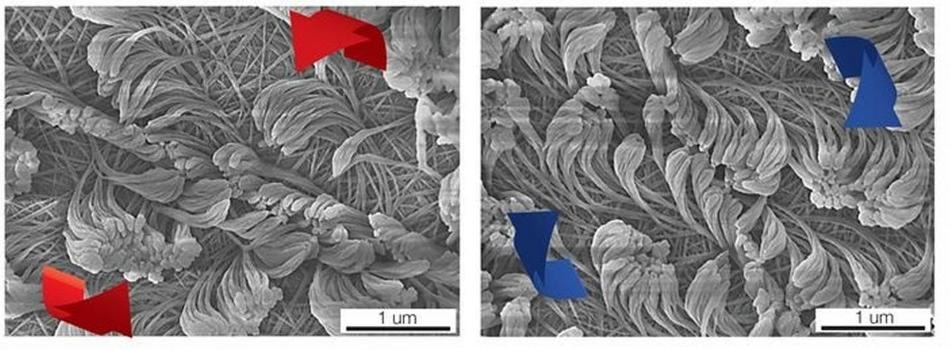Nov 19 2018
Composed of the finest of fibers, polymer pelts are ideal for a variety of applications that range from highly sensitive biological detectors to coatings that adhere well yet can be removed easily.
 Nanofibers with different directions of rotation. (Image credit: Kenneth Cheng, University of Michigan)
Nanofibers with different directions of rotation. (Image credit: Kenneth Cheng, University of Michigan)
Now, scientists at Karlsruhe Institute of Technology (KIT) along with researchers in the United States have come up with a cost-effective process in which a liquid crystal layer is exposed to reactive molecules through vapor deposition to enable the growth of customized polymer nanofibers on a solid substrate. The team has reported this novel technique in the journal Science (DOI: 10.1126/science.aar8449).
Surfaces that have uniquely aligned fibers abundantly exist in nature and execute various functions, for example, adhering, sensing, and self-cleaning. For instance, the geckos’ feet are covered with a countless number of hairs that enable them to stick on to surfaces and pull off again quite easily. The development of such surfaces from artificial materials presents new opportunities for a wide range of applications. Yet, previously available techniques for the development of polymer pelts on solid bases have been shown to be expensive. More significantly, the fibers’ alignment, size, and shape can be controlled only to a certain extent with traditional techniques.
Now, a simple and thus cost-effective process has been developed by a research team from the Institute of Functional Interfaces (IFG) of KIT, the University of Wisconsin-Madison, the University of Michigan, and Cornell University in Ithaca, New York. This process enables the growth of polymer pelts in a self-organized fashion. The research team, headed by Professor Joerg Lahann, Head of the Department of New Polymers and Biomaterials at KIT’s IFG and Director of the Biointerfaces Institute of the University of Michigan, has described the novel process in the journal Science.
The researchers first used a thin layer of liquid crystals to cover a carrier. These liquid crystals are liquid substances that possess directional properties and are mostly used for displays and screens (liquid crystal displays or LCDs). They then exposed the liquid crystal layer to activated molecules through vapor deposition. The reactive monomers, thus formed, enter the layer of liquid crystals, thereby growing from the substrate into the liquid in the form of fine fibers.
Consequently, this produces polymer nanofibers that can be customized in shape, length, arrangement, and diameter. The intricate yet accurately structured polymer pelts, thus formed by the fibers, can be used in a wide range of applications, particularly for bioinstructive surfaces that are capable of interacting with their environment, biological detectors, and for coatings that possess novel properties. This also comprises of surfaces that have dry adhesion properties, analogous to those of the feet of geckos, albeit adhesion in nanofibers is based on the atoms’ unique spatial arrangement in the molecules (chirality—handedness).
The work at the “Molecular Structuring of Soft Matter” Collaborative Research Center (CRC) was supported by the German Research Foundation (DFG). In KIT’s 3D Matter Made to Order (3DMM2O) cluster and the University of Heidelberg, which will be funded in the Excellence Strategy by the state and federal governments from January 2019, customized materials will also be given precedence. Professor Christof Wöll, the Head of KIT’s IFG, is involved as one of the key researchers in the 3DMM2O Excellence Cluster, which integrates engineering and natural sciences and focuses on three-dimensional (3D) additive production technologies from a macroscopic to molecular level.